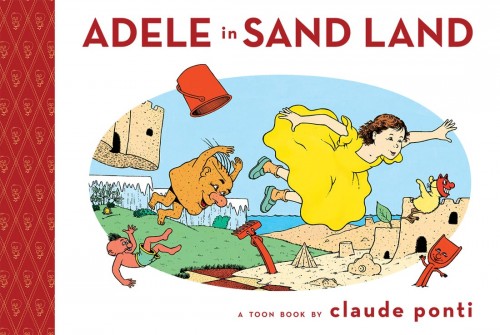
Review: ‘Adele in Sand Land’
Adele in Sand Land
By Claude Ponti
Toon Books
When I was a kid, my mother used to buy me a lot of books at garage sales. Many of them dated back to the period 1900-1940 and had a crazy, old-fashioned, almost scary look to them. I loved them—they were so far from the sanitized sweetness of the Bobbsey Twins and the Scholastic Book Club books I was reading—and later on I saw echoes of them in underground comics. (I can’t remember too many of the titles now, but Johnny Gruelle’s Raggedy Ann books come close.)
Claude Ponti’s Adele in Sand Land starts off as a fairly ordinary picture book—Adele and her mother go to the park, ho hum—but within a few pages it slides off into a surrealistic adventure that’s only barely tethered to reality. Adele packs some sand into a bucket, turns it over, and the packed sand sprouts a bulbous nose and a few sprigs of hair and comes alive. As this happens, the park bench that Adele’s mother is sitting on tilts and moves up off the ground, her doll comes to life, and a face appears in a tree. Then the rest of the trees turn to birds… and so it goes. There’s no real plot to this story, just a series of short visits to stranger and stranger lands. Adele and her friends are swallowed by a Sand Dragon, locked in a Cage Bird, visit a Dessert Island, and fly off in a giant nose.
ADVERTISEMENT
ADVERTISEMENT
Every two-page spread in this book is a gem. Ponti’s art has a dreamlike quality to it, as the objects in his drawings are continuously transforming in ways that are weird but make visual sense: Ice cubes turn into ice cream bars, which turn into giant erasers; irregularities in a tree’s foliage turns into a face. At the same time, his crisp line and detailed drawings keep everything grounded in a believable pseudo-reality. The march of vertical panels across the page, and the way that images change from one panel to the next, is reminiscent of the classic comic Little Nemo in Slumberland.
If Adele has another counterpart in children’s comics right now, it would be Luke Pearson’s Hilda, who similarly lives in a world in which everyday reality and magical elements interweave. Hilda is a more active protagonist—she propels the action, while Adele is more of an observer—but Ponti’s imaginative story has a sense of motion of its own, as Adele and her friends slip seamlessly from one strange world to the next. The images are filled with details, making this a great book for an adult and child to read together, pointing things out as they go, or alone, all the better to pore over the pages and take in every detail.
About Brigid Alverson
Brigid Alverson, the editor of the Good Comics for Kids blog, has been reading comics since she was 4. She has an MFA in printmaking and has worked as a book editor, a newspaper reporter, and assistant to the mayor of a small city. In addition to editing GC4K, she is a regular columnist for SLJ, a contributing editor at ICv2, an editor at Smash Pages, and a writer for Publishers Weekly. Brigid is married to a physicist and has two daughters. She was a judge for the 2012 Eisner Awards.
ADVERTISEMENT
ADVERTISEMENT
SLJ Blog Network
2024 Books from Pura Belpré Winners
In Memorium: The Great Étienne Delessert Passes Away
Parsing Religion in Public Schools
Finding My Own Team Canteen, a cover reveal and guest post by Amalie Jahn
ADVERTISEMENT








